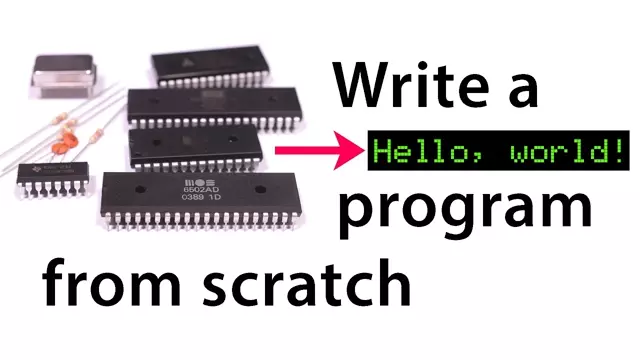2019-09-14
[public] 2.70M views, 124K likes, 906 dislikes audio only
Learn how computers work in this series where I build and program a basic computer with the classic 6502 microprocessor. More info: https://www.eater.net/6502
Part 2: /youtube/video/yl8vPW5hydQ
Part 3: /youtube/video/oO8_2JJV0B4
Part 4: /youtube/video/FY3zTUaykVo
Part 5: /youtube/video/xBjQVxVxOxc
Part 6: /youtube/video/i_wrxBdXTgM
Part 7: /youtube/video/omI0MrTWiMU
Support these videos on Patreon: https://www.patreon.com/beneater or https://eater.net/support for other ways to support.
------------------
Social media:
Website: https://www.eater.net
Twitter: https://twitter.com/ben_eater
Patreon: https://patreon.com/beneater
Reddit: https://www.reddit.com/r/beneater
Special thanks to these supporters for making this video possible:
Alex Catchpole
Armin Brauns
BakerStaunch
Beau-James Erion
Ben
Ben Dyson
Ben Kamens
Ben Williams
Bradley Pirtle
Christopher Blackmon
Clayton Parker Coleman
Daniel Tang
Dean Winger
Debilu Krastas
Dominic Kulmer
Dušan Dželebdžić
Eric Brummer
Eric Dynowski
Erik Broeders
Eugene Bulkin
fxshlein
HaykH
Ian Tait
Ivan Sorokin
JavaXP
Jay Binks
Jayne Gabriele
Jefferson Hunt
Jimmy Campbell
Joel Messerli
Joel Miller
Jordan Scales
Joshua King
Justin Duch
Kent Collins
Manne Moquist
Marcus Classon
Mats Fredriksson
Michael
Michael Burke
Michael Garland
Miguel Ríos
Nathan Wachholz
Nicholas Moresco
Onion Sniffer
Paul Pluzhnikov
Peter Simard
Randy True
Robert Butler
Sachin Chitale
Sergey Ten
SonOfSofaman
Stefan Nesinger
Stephen Smithstone
Steve Gorman
Thomas Ballinger
Vladimir Kanazir
xisente
Örn Arnarson
/youtube/video/kRlSFm519Bo
/youtube/video/LnzuMJLZRdU?t=76.089996
/youtube/video/LnzuMJLZRdU?t=82.150002
/youtube/video/LnzuMJLZRdU?t=88.779999
/youtube/video/LnzuMJLZRdU?t=130.39
/youtube/video/LnzuMJLZRdU?t=154.63
/youtube/video/LnzuMJLZRdU?t=182.92
/youtube/video/LnzuMJLZRdU?t=234.819
/youtube/video/LnzuMJLZRdU?t=266.01999
/youtube/video/LnzuMJLZRdU?t=318.95999
/youtube/video/LnzuMJLZRdU?t=375.32999
/youtube/video/LnzuMJLZRdU?t=403.04999
/youtube/video/LnzuMJLZRdU?t=434.63901
/youtube/video/LnzuMJLZRdU?t=437.63901
/youtube/video/LnzuMJLZRdU?t=442.19901
/youtube/video/LnzuMJLZRdU?t=522.14899
/youtube/video/LnzuMJLZRdU?t=551.71002
/youtube/video/LnzuMJLZRdU?t=579.15997
/youtube/video/LnzuMJLZRdU?t=603.96997
/youtube/video/LnzuMJLZRdU?t=659.56
/youtube/video/LnzuMJLZRdU?t=677.51898
/youtube/video/LnzuMJLZRdU?t=725.06897
/youtube/video/LnzuMJLZRdU?t=739.22998
/youtube/video/LnzuMJLZRdU?t=771.62903
/youtube/video/LnzuMJLZRdU?t=786.12
/youtube/video/LnzuMJLZRdU?t=838.54999
/youtube/video/LnzuMJLZRdU?t=859.25
/youtube/video/LnzuMJLZRdU?t=876.91998
/youtube/video/LnzuMJLZRdU?t=903.77002
/youtube/video/LnzuMJLZRdU?t=954.33002
/youtube/video/LnzuMJLZRdU?t=1015.92
/youtube/video/LnzuMJLZRdU?t=1062.5
/youtube/video/LnzuMJLZRdU?t=1098.62
/youtube/video/LnzuMJLZRdU?t=1139.45
/youtube/video/LnzuMJLZRdU?t=1157.54
/youtube/video/LnzuMJLZRdU?t=1174.1899
/youtube/video/LnzuMJLZRdU?t=1277.52
/youtube/video/LnzuMJLZRdU?t=1303.02
/youtube/video/LnzuMJLZRdU?t=1341.51
/youtube/video/LnzuMJLZRdU?t=1402.35
/youtube/video/LnzuMJLZRdU?t=1435.2
/youtube/video/LnzuMJLZRdU?t=1483.37
/youtube/video/LnzuMJLZRdU?t=1506.83
/youtube/video/LnzuMJLZRdU?t=1577.48
https://www.eater.net?utm_source=yt&utm_medium=endcard&utm_campaign=6502-1
/youtube/channel/UCS0N5baNlQWJCUrhCEo8WlA
/youtube/video/yl8vPW5hydQ

